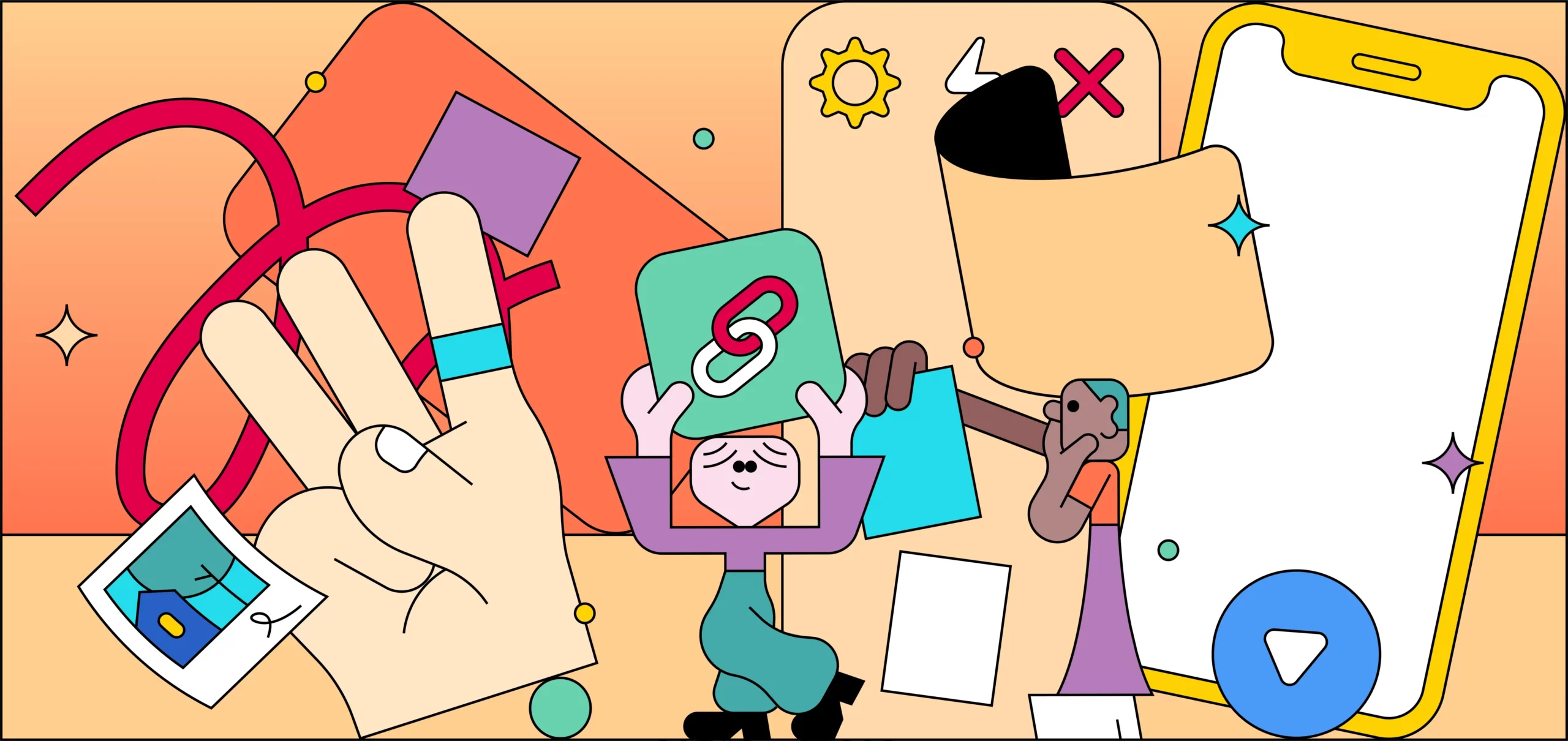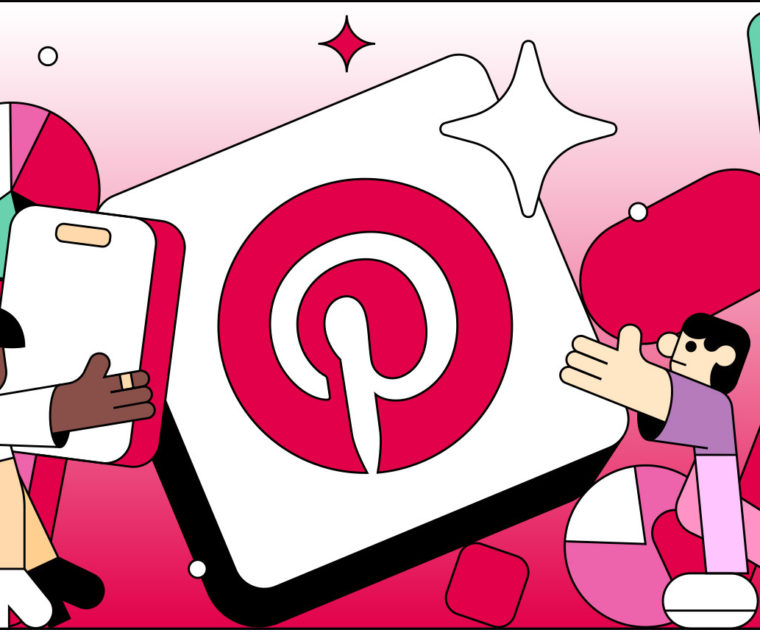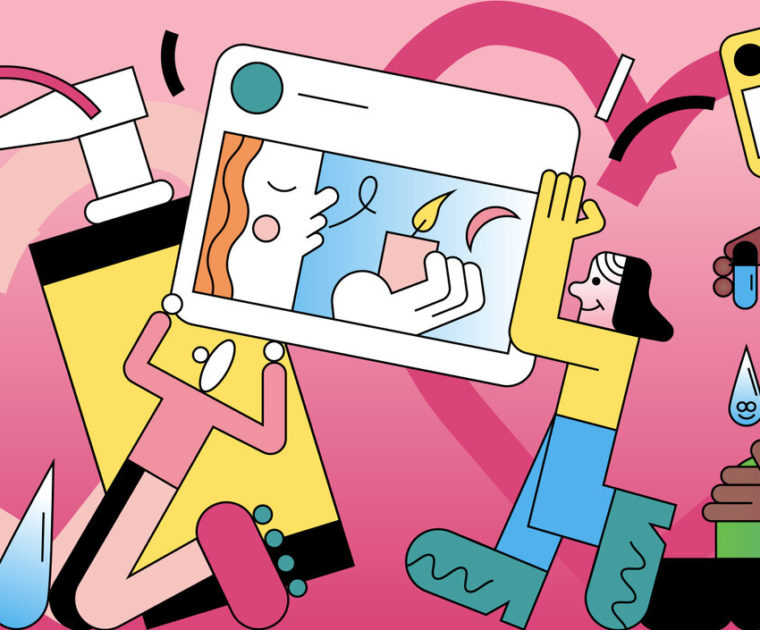Bloggers may be clued in on something your brand is actually missing: Pinterest is an AMAZING product discovery tool. That fact alone makes Pinterest a valuable channel to leverage as part of your digital marketing strategy, and especially your influencer marketing strategy.
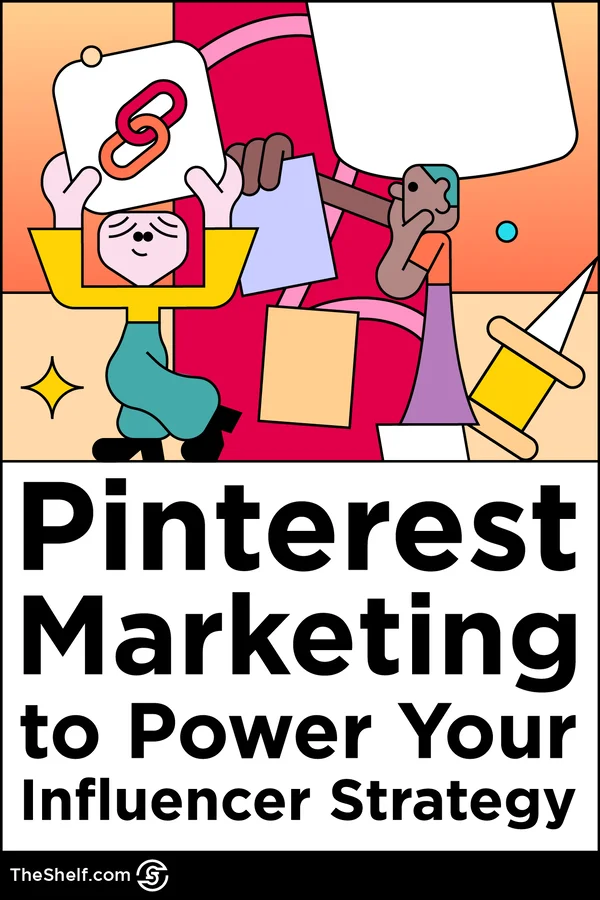
About 85 percent of Pinners head to the platform when they’re ready to start planning new projects, and 82 percent of Pinners say they have made a purchase based on a product they saw on Pinterest. And 93 percent of Pinners say they use Pinterest to plan future purchases.
As marketers, the goal isn’t convincing Pinterest users that they need to buy because they already have a purchase intent. Instead, the goal should be:
- Understanding your audience – Pinners tend to be the decision-makers in the household.
- Monitoring trends – Pinners are planners.
- Meeting consumers at the right time with the right message – Pinners spend twice as much time shopping each month than people off the platform, and they spend more than a quarter of their time on the platform shopping. 75 percent of weekly Pinners say they’re “always shopping.”
Pinterest presents a powerful marketing opportunity that can not only get your products in front of shoppers who have their wallets in hand but can also drive huge amounts of traffic to your website.
In this post, I’m going to help you build a Pinterest marketing strategy (you’re welcome) that will fortify your next influencer campaign.
What We Cover In This Post on Pinterest Marketing
- A Quick Overview of Pinterest
- Pinterest Demographics: Who Uses Pinterest?
- User Behaviors That Make Pinterest an Influencer Marketing Goldmine
- Optimizing Your Influencer Campaign with Pinterest Marketing
- Making Your Pins Shoppable
- Tips for Making Pinterest Marketing Work for Your Business

A Quick Overview of Pinterest
What Is Pinterest?
Pinterest is a visual discovery platform that allows its 445 million monthly active users to create (or “pin”) their own visual content, or bookmark (“repin”) other users’ pins. Imagine if Instagram and Google got together and had a digital baby. That’s Pinterest. Pinterest is one part social media platform, one part search engine, and one part digital scrapbook.
There are over 240 billion pins currently uploaded to Pinterest and its users have created 4 billion boards. Each pin contains a title, description and a link to where the content being pinned lives on the web (usually the link goes to a blog or a sales page).
Pinners must also assign every pin a board like the ones you see here 👇 from Target’s official Pinterest account. A board is a collection of pins, usually organized topically.
Pinterest is largely driven by visual content that can quickly travel across the platform, and to every corner of the world wide web to bring new visitors to your blog, website, or online store. The platform accounts for up to 8 percent of all referral traffic to websites.
Pinterest was pretty innovative, right out of the gate
When Pinterest first launched in 2010, it was invitation-only. Do you remember that – waiting to hear back from Pinterest and not even fully getting what it was? I distinctly remember my buddy Ron urging me to get waitlisted for this thing. I did, and it was literally weeks before I was let in. Even still, I don’t think I really started using it for another two or three years. In spite of the invite-only launch, Pinterest ended up being the fastest site in history to reach 10 million monthly active users.
Here’s the bit that will interest marketers:
Pinterest attracts people who flock to the platform for inspiration on what to buy. That means you can reach a large portion of your audience, as they are actively looking for products, with marketing messages that are going to be well-received.
I use Pinterest to collect a running tally of things I want to learn, find, try, or buy. This can include things like figuring out how to stop killing my dahlia, finding fitness influencers I trust and buying whatever stuff they tell me I need (Brittne Babe and Nardia), or setting up the extra bedroom as a remote learning spot for my kids.
From the beginning, Pinterest has been a hub for the crafts and DIY communities, as well as various lifestyle verticals like beauty, fashion, and home decor which are driven by visual content. But Pinterest is a growing hub for verticals that aren’t visually focused, like personal finance.
According to Pinterest…
- Most Pinners are in the market for at least one financial service. Financial companies like American Express, Business Insider, and Bank of America boast an accumulated monthly Pinterest viewership of over 25 million. (I have an entire board called “My Money Game.”)
- Travel searches were up 60 percent in 2022, with Pinners creating boards for places they want to visit, hotels, lodging, and activities for upcoming vacations
- Pinners use the app for car shopping too. In 2021, branded automotive pins performed 62 percent higher than dealership’s home websites.
Pinterest is for more than the DIYers, it’s for all consumers. Today Pinterest is the platform that eight in ten Americans know about, and four in ten are actually using.
Pinterest User Demographics: Who Uses Pinterest?
Me. I use Pinterest. Faithfully. But also, like a bunch of other people, too. So…
Early on, Pinterest earned a reputation for being the place moms and crafters went to hang out and dream up ideas, but there is a much wider diversity in Pinterest’s audience than you might think.
More than 75 percent of the platform’s audience is outside the United States. And 75 percent of Pinterest users are women. One in three U.S. adults between the ages of 18 and 29 use Pinterest, as well as 34 percent of those between 30 and 49, and 38 percent of adults between the ages of 50 and 64 use it. Regardless of age, Pinterest is a mother’s paradise. A whopping 80 percent of U.S. moms are on Pinterest.
And their kids are, too! Gen Z Pinners are up 40 percent year over year and U.S. millennial Pinners are up 35 percent. Gen Z purchased 80 percent more new products than other generations in 2022. It makes sense that brands that connect with Gen Z can see 14x the revenue growth opportunity compared to those targeting other generations.
Most people use Pinterest to look at pictures (60 percent) and find/shop for products (55 percent). It’s also a place to watch videos, with more than one billion watched on the platform each day. Pinterest was the second most visited social media site in 2022 (after Facebook). Probably because 66 percent of users say Pinterest is their go-to search engine.
That makes sense to me. Here’s why…
If you were to search for “short blond pixie cut” on Google then perform the same search on Pinterest, different results would show. More importantly (for searchers), Pinterest filters the results a little smarter for stuff like this.
In the two screenshots below, check out the filter options along the top of each picture (and the fact that Google results INCLUDE Pinterest pins).
Versus…
Pinterest also does a better job of integrating sponsored content a little more naturally with your actual results.
Actually, let’s try it for another popular Pinterest topic – home decorating. The search term is “small bedroom ideas”. I actually had to scroll down a bit because the first row on Google was sponsored content/products.
Now, it’s not that people don’t want to shop on Pinterest. The truth is actually quite the opposite. Pinterest is the social platform users are MOST likely to choose when they are ready to spend money. In fact, shoppers on Pinterest spend 2x more than shoppers on other social platforms.
Ninety-seven percent of Pinterest searches are unbranded, meaning users are open to suggestions from brands. In fact, 78 percent of Pinterest users say they want to see branded content, and more than half of shoppers name Pinterest as their platform of choice for finding and shopping for products. While other platforms have pulled ahead in terms of social commerce, Pinterest still commands a large portion of online shoppers.
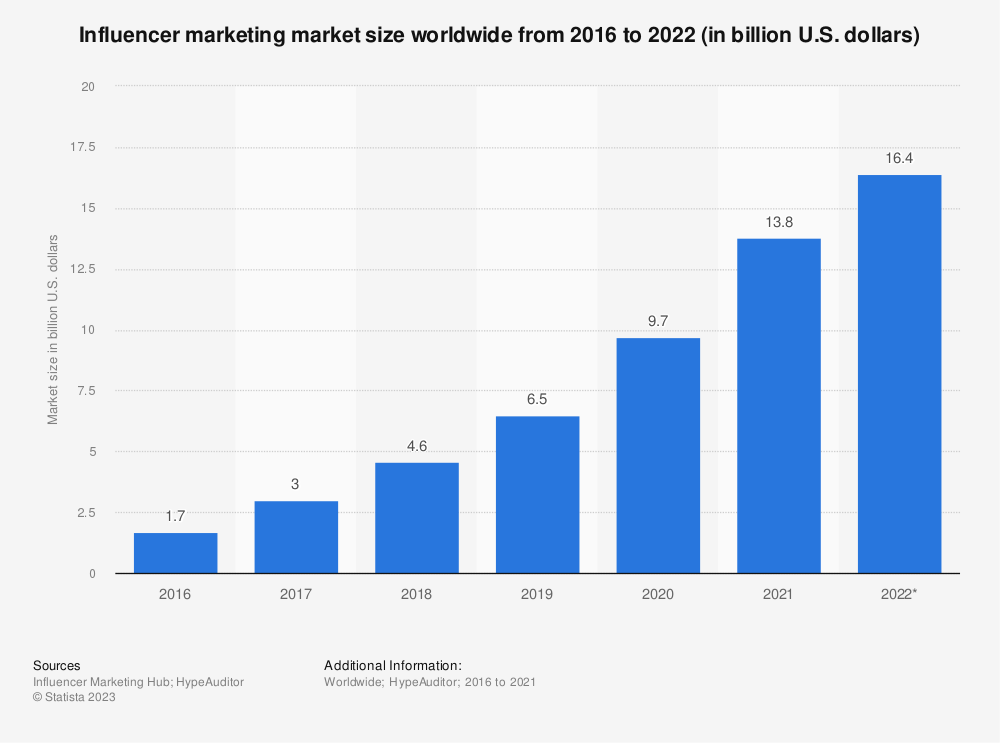
User Behaviors That Make Pinterest an Influencer Marketing Goldmine
Take a look at the picture below, captured on a random trip to McDonald’s during in the summer of 2019.
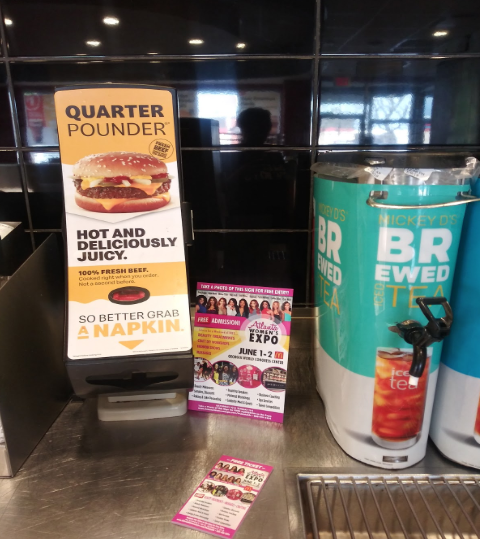
That June, McDonald’s sponsored the Women’s Expo in Atlanta, GA. In case you’re wondering, Atlanta is a global destination point. It’s home to a sizable entertainment industry hub, with countless television shows and movies being filmed here, everything from Marvel Studios to Vampire Diaries (one of our neighborhood pizza joints is Mystic Pizza – my daughter loves that).
In 2019, the celebrity lineup for the Atlanta Women’s Expo was nothing to sneeze at – reality stars, social media stars, movie stars…these women are famous.
But it wasn’t just McDonald’s that was involved. To give you a better idea of the scope of this event, other sponsors included luxury brands like Chanel, Coach, Michael Kors, Jimmy Choo and Dior, as well as retail heavyweights like The Home Depot, Walgreens, and Kroger.
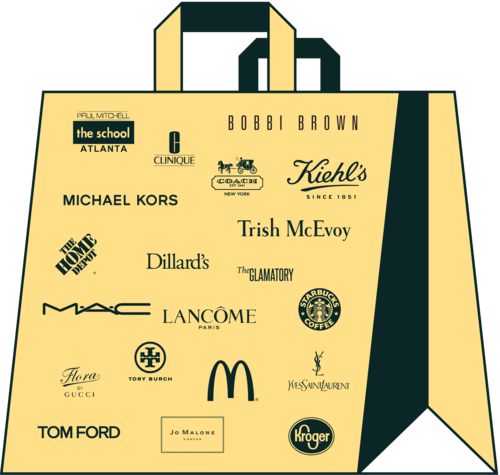
Why am I telling you this? Because upon closer examination of the poster, you can see that one of the featured workshops for this event, which draws tens of thousands of women every year, is a Pinterest workshop. So, let’s talk about why that is.
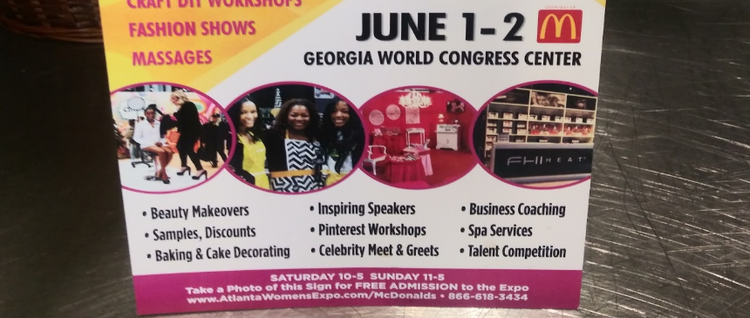
Pinterest is the fourteenth most popular social media site, but its users are highly engaged. Eight in ten say using Pinterest makes them feel positive. Most Pinners think of Pinterest as a bright spot on the web, calling it a place where positivity lives.
Pinterest Has Cross-Generational Appeal
Whether Gen Z, Millennials or Boomers, adults love Pinterest. They love having a one-click storage place of awesome photos and cool ideas. They love having a place where they can build targeted audiences whose ideas and tastes align with their own.
Pinterest Time is Me Time
Pinterest is where people go to source and collect ideas to help them be their best selves. The fact that Pinterest is so heavily aspirational (with no PERSON in particular to be the target of anyone’s love-hate aspiration) keeps Pinterest from earning the same stigma as some of the other popular social networks.
There are no reports of Pinterest-fueled depression or rage. It’s aspiration without the stigmas. It’s no real surprise (especially to anyone who actually uses the platform) that 1 in 2 U.K. Pinterest users call the platform an “online oasis.” This is likely due, in no small part, to Pinterest banning political ads in 2018.
Pinterest is a Positive Corner of the Internet
Pinterest gives all the feels. Pinterest is the platform that helps people feel more creative, inspired, and organized. Ninety percent of weekly Pinners describe the platform as filled with positivity. Less than a third felt that way about competitor platforms like Instagram and Facebook. And 86 percent of Pinners also use Instagram.
Pinners are Planners…and They Plan Waaaay In Advance
Pinners are planners. While Pinterest users post about seasonal events year-round, there are noticeable spikes in engagement with holiday- and event-related content in the weeks before that holiday or event. Seasonal pins drive 22 percent higher online sales.
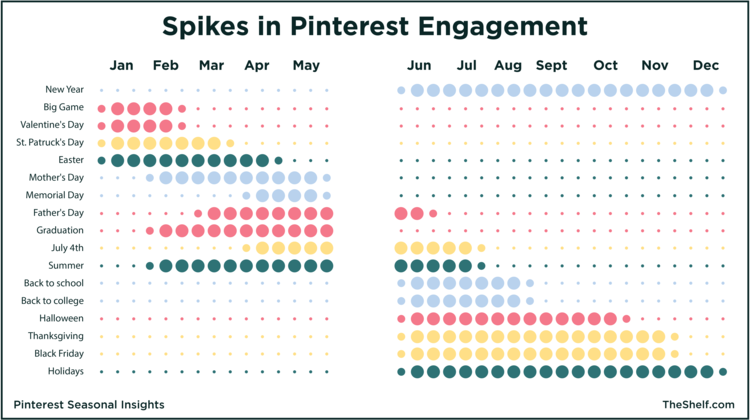
But if you notice, the posts start typically a few months ahead of the holiday. Pinterest users tend to start planning twice as early as people who use other platforms. It’s not uncommon for holiday campaigns to begin nine months in advance. Heck, Father’s Day ideas start circulating around the platform as early as March and interest in Halloween starts to spike in June.
Holidays aren’t the only dates on Pinners’ calendars. Pinners also use the platform to plan life’s important milestones, like buying a new home, decorating said home, getting married, and going on vacation.
Pinners Are Purposeful
Pinterest users are more likely to use the platform for the intention of finding products and ideas, as opposed to just using the platform to kill time. Eighty-nine percent of users use Pinterest to make purchase decisions.
Pinners Favor Mobile
Pinterest users heavily favor the app. Eight in ten users access Pinterest on mobile devices and 85 percent of Pinterest searches are on mobile.
Pinners Use Pinterest to Source Ideas
Pinterest is the go-to spot on the web for people to discover new products and source new ideas, and part of the reason branded content is so effective is because Pinterest shows new content based on what people have seen and engaged with before. This personalization helps the platform naturally integrate product ideas and Promoted Pins in a way that doesn’t look like ads or make users feel like they’re being marketed to.
Pinners Are Buyers
While most social media platforms are shoppable now, Pinterest users go to the platform with purchase intent. Eighty percent of Pinners say they’ve made a purchase based on something they saw on Pinterest.
Half of all Pinners make a purchase after seeing a promoted pin. And, since two in three Pinterest users are actively looking to make their next purchases, smart marketers can leverage the platform as a way to generate both traffic and revenue.
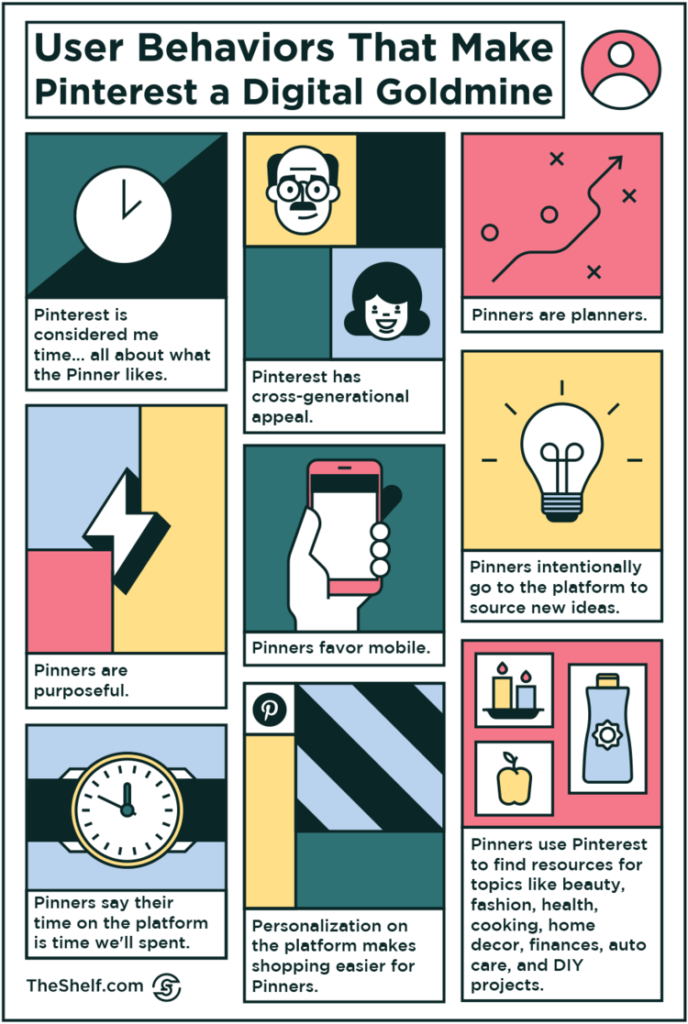
COPY AND PASTE THIS CODE TO EMBED ON YOUR SITE
Optimize Your Influencer Campaign with Pinterest Marketing
Now you know the latest on what Pinterest is used for and who’s using it. Let’s dig into how to make the most of those stats for your next campaign.
Recent Updates to Pinterest Will Make Influencer Campaigns Way More Effective
In recent years, the geniuses over at Pinterest have been rolling out updates and changes that will make marketing on the platform A LOT easier. Most of the biggest changes happening with Pinterest are similar to the ones we’ve seen with the Google algo over the past few years.
Pinterest wants to make sure the in-feed content it shows Pinners is content that’s high in quality, relatively recent, loaded with value and compels people to engage (i.e. stay on the platform).
According to a MEDIUM post from one of the platform’s Engineers, Recency and Relevance are two of the most important factors that determine what content shows up in users’ feeds.
Pinterest Favors Recency
Recency is about keeping the users’ feeds fresh. Before, Pinterest feeds were largely based on user engagement data: what’s already popular on Pinterest + user preference based on previous engagement.
That’s not the case anymore. Now, Pinterest surfaces a lot more recent content, as the algorithm now favors new pins over repinning. In fact, pins with the word “new” in their text overlay lead to nine times higher aided awareness. That’s great news for your next campaign, right?
With the new algorithm, a pinner’s home feed will be a mix of content from the other Pinners they follow (trust me, it becomes a really compelling reason to follow more Pinners), the topics in which they’ve shown the most interest (i.e., stuff that fits the other stuff they’re pinning to boards), ads, and video or multimedia content (we’ll get into this later in this article).
Pinterest Favors Relevancy
Relevance has a lot to do with user experience on Pinterest. The platform has taken some pretty big steps in recent years to influence how different topics and content types show up in-feed.
For example… previously, to keep from sharing misinformation, Pinterest would suppress searches most likely to turn up questionable or controversial info, like a search on vaccines.
Now, instead of suppressing searches, Pinterest presents information from trusted experts ONLY and removes users’ ability to comment and provide feedback on that info.
The Pinterest Algorithm Accounts for Several Factors to Determine Relevance:
- Attainable – Can the user take action on the content? Pins need to compel people to try, make, or do.
- Authority – Is original content from a trustworthy source? Is it from someone who has made a name for herself in this category? Does the pin link out to a trustworthy website?
- Visually Appealing – Does the creator have a knack for creating compelling images/videos that can grab attention? Is the pin branded (with your brand or your influencer’s brand)? Does it have text overlay with a clear message that tells people what the pin’s about?
- Positive – Does the pin inspire more ideas or motivate users to do something cool? Pinterest pegs itself as the last feel-good corner of the web.
- Searchable – Is the blog post title compelling enough to push people to save the pins? Are both the title and the pin description keyword optimized? Do they include hashtags?
- Pinnable/Shareable – Is the value prop/benefit of your product highlighted either in the title or somewhere else in the pin?
- Strong CTA – Remember, you’re making these suckers actionable, so it’s okay to tell people which actions to take.
Another big one for that algorithm we mentioned earlier is that it’s also deliberately showing certain content to ensure not only cultural representation, but content from businesses of different sizes. Part of Pinterest’s commitment to help small businesses impacted by the current business environment.
So…
The new algorithm favors newer content which is perfect for those seasonal or holiday influencer campaigns.
Pinterest also favors content that ticks the boxes of “Controllable Distribution”, a process the engineers use to make sure certain content types are showing up in feed results.
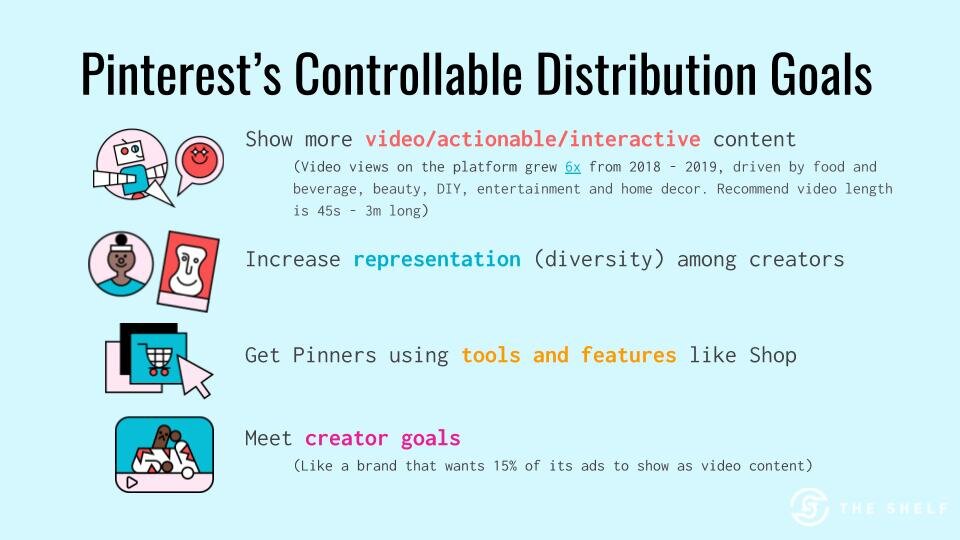
The Verified Merchant Program
The first step for any brand planning to leverage Pinterest for marketing is to become a Verified Merchant. Pinterest uses this program to judge the legitimacy of a brand. Only pins from Verified Merchants surface when Pinners choose to Shop, Shop Collections, or Shop Similar.
Verified Merchants have:
- a digital footprint besides Pinterest
- a secure website
- high-quality website content and product pages (quality product photos – no stock photos)
- a way of providing daily inventory updates (usually via RSS)
Brands that sell affiliate products, upcycled goods, animals, and services aren’t eligible to become Verified Merchants.
Create Multimedia Ads from Multiple Pin Formats
Remember that Pinterest, like all social media platforms, places priority on content that can get people to engage and spend more time on the platform. That means skipping the part of life where you’re stuck styling pins for hours on end, and opting instead for multiple media formats.
One of the cool things about becoming a Verified Merchant is that you can upload your product catalog (Pinterest can handle up to 20 million product pics per account), and each product is made into its own Pin. But if you don’t take that route, there are other formats you can use. The more the merrier.
Image Pins
Your typical image pin should be eye-catching and even stop other Pinners mid-scroll. If you have the ability to stage and capture stunning photographs or have an entirely visual product, then image only pins can be valuable.
Of course, sometimes the thing you’re selling is content, ideas and affiliate products. In that case, the goal is to create a well-designed, eye-catching pin where the title is compelling enough to warrant being bookmarked.
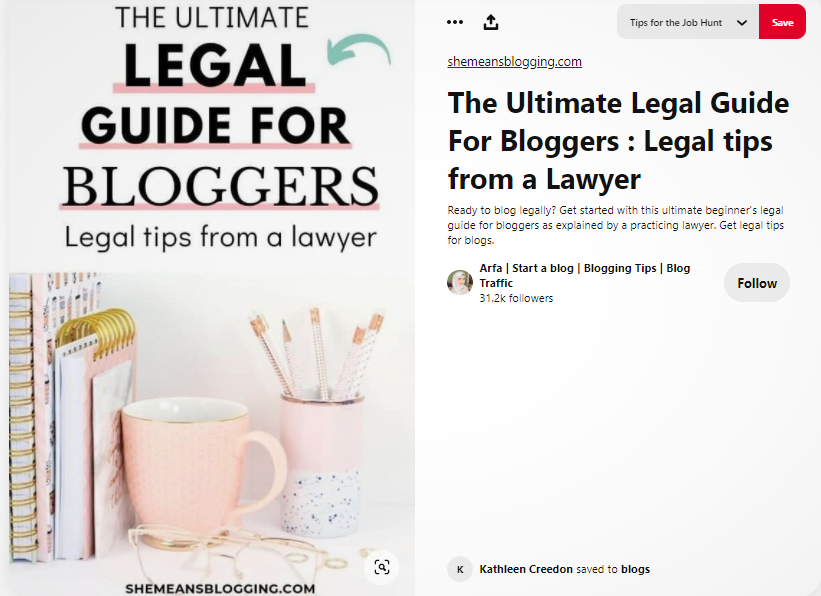
Video Pins
In addition to your standard image pins, you want to create more video/actionable/interactive content. Pinterest favors pins that will get people to take an action, and video is great for this.
Video views on the platform have grown to one billion daily, driven by food and beverage, beauty, DIY, entertainment and home decor. For ads, recommend video length is 6-15s long. Although, you can make videos anywhere from 4 seconds to 15 minutes in length. Use super-short videos (with audio) to catch Pinners with cool demonstrations.
Product Pins
These are the pins that show up when Pinners show purchase intent. Pinners use the platform to create dream collections, so having high-quality images they can swoon over should be part of your strategy.
Story Pins
Story Pins are multi-page Pins that pretty much last forever. Pinners can add images, videos (up to 60s), and text overlays to each pin.
Story Pins reach your followers + anyone who has shown an interest in the topic, so it makes sense to rely on your hashtag strategy and keyword strategy here.
Story Pins are a great way to detail a step-by-step process, create a supply list, ingredients list for recipes, and embed products in outfit and decor inspo boards.
With Story Pins, brands can contextually embed products as part of a single overarching theme where your product isn’t the focus.
In the example above, a Story Pin is dreamed up by a young Pinner about where she would like to shop. And if you’ll notice, the Pinner isn’t even the person featured in all the pins… because Pinterest is about sharing ideas, not social validation.
Create Multiple Keyword-Optimized Pins and Boards
It’s a good idea for your influencer partners to create multiple pins for each sponsored post, optimized for different keywords.
An easy way to do it is to pull different titles from relevant H2s and H3s that are in the blog post you’re linking to (you may need to work with influencers to ensure those H2s are properly optimized, too).
If you’re creating multiple pins for each message or audience you’re targeting in your campaign (which you definitely want to be doing), keyword optimization is one of the key strategies you’ll want to keep in mind because you’ll be able to reach Pinners by:
- their interests
- the keywords they search when they’re looking for content on a particular topic or idea
- actalike audiences that target people similar to your existing audience
Don’t forget to target. You can even have different pins targeting different points in the purchase cycle.
Let’s use the Levi’s pin as an example.
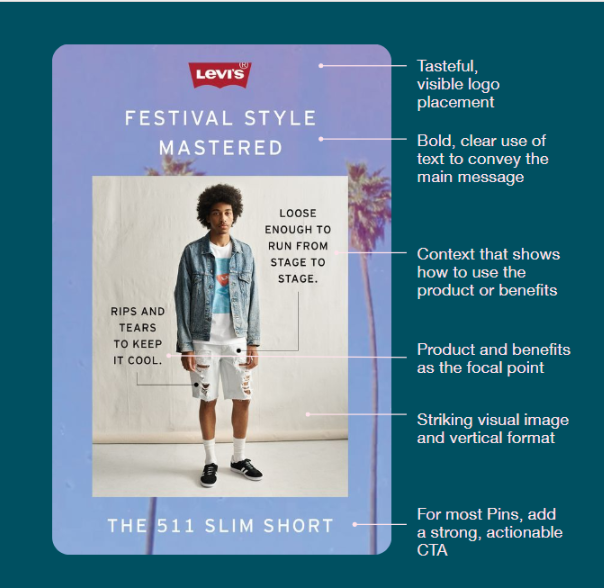
Pins can also target subgroups of a larger demographic by angling pins toward seasonal or event-focused concepts. Like one pin for choosing Festival-Style jean shorts and another for making sure your pre-made holes don’t get all stretched out.
The general idea is to show Pinners the different benefits and applications of your product.
Don’t Forget About Your Boards
Each board you create can be classified as either Public, Secret, or Group. Best practices indicate that creating 10 boards initially is a good way to start, with each board tailored to your target audience in order to attract them to your pins.
Pinterest serves two billion searches a month. As you can imagine, Pinners will need a way to find your content. That’s where your keywords strategy comes in. Your keywords are going to be vital when naming and creating your boards. Choosing which topics to focus your boards on should be based on the keywords you think are most important to your brand.
Loop In Bloggers and Influencers Who Are Active on Pinterest
Here’s where you can add variety, reach, and SEO value to your otherwise awesome Pinterest ad strategy.
Partnering with bloggers and influencers to create content that contextually embeds your product allows you to leverage the social proof offered by bloggers who can demonstrate the real-life application and value of your product, or give people a really compelling reason to go to your store.
So, during the influencer selection process, choose a few bloggers who have had multiple pins get repinned a bunch of times.
Note: Bloggers usually style their blog pins differently than a product pin, and blogger pins link back to individual blog posts, so you’ll want to have product pins that go back to your product pages AND blogger pins that go to the blogger’s site. Just be sure the blogger includes high-quality pics of your product in action.
BONUS: If you notice, to the right of the pin above, you’ll see that Pinterest allows Pinners to comment on and post pictures of the pins they’ve tried. You can have other influencers in your campaign post examples of how they used your product or what they found in your store to provide that extra nudge of social proof.
SHOPPING SPOTLIGHTS AND LOCAL TARGETING BOOST STORE TRAFFIC
Shopping Spotlights is an influencer-curated list of shoppable recommendations based on current Pinterest Trends. The lists surface for users according to their interests, previous behavior with similar content, AND THEIR LOCATION.
** Since Pinterest is aiming to display local retailers as part of its push to support small businesses. Seriously… you gotta start pinning stuff!
For this feature, Pinterest is bringing in well-known style influencers (including bloggers, magazine editors, and designers) to create articles/content with shoppable links/products embedded in them.
Plus, influencers will do “lookbook” types of catalog pages – again, based on Pinterest Trends – curated by brands
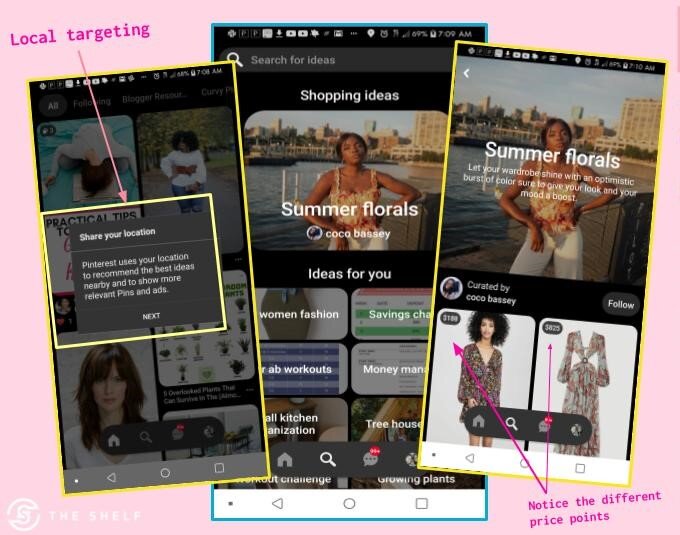
Make Your Pins Shoppable
You can shortcut the path to purchase by making your pins shoppable to allow Pinners to click your pin and go straight to your online store.
Shop from Boards – When a Pinner visits your board, they’ll now see a Shop tab that shows products from (or inspired by) the Pins on your board. You wanna show up in those recommendations? Time to start pinning and getting pinned.
Shop from Search – Shop tab appears on search, making it easier for Pinners to shop in-stock products from different retailers when searching for terms like “spring outfits“, “office decor“, “DIY kitchen remodels“. Pinners can also filter by price and brand now. (Start pinning!!)
Shop from Pins – Pinners can shop similar products right from the Pins shown in visual search. Just click “shop similar” to see related in-stock products for looks and rooms.
Shop from Style Guides – Browsable style guides appear for “ideas” searches. These visual recommendations make it possible to explore trending styles, new products, and “style profiles” even when you don’t have exact words to describe what you’re looking for.
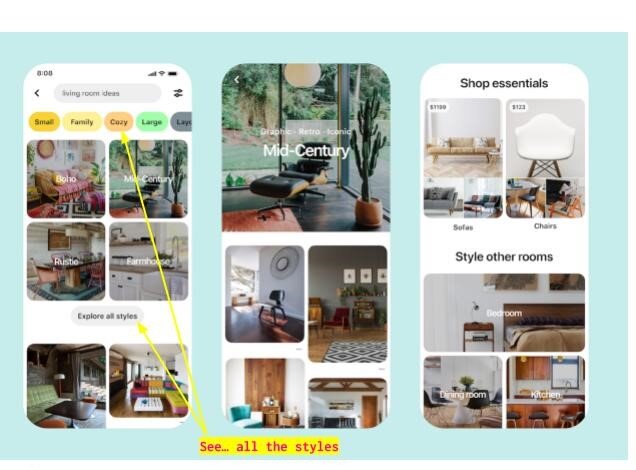
Shop from Lens – Pinterest has been consistently improving on the performance of its Lens function, which lets you snap a picture of an object you see while you’re out and about and use that pic to find similar objects from different brands on Pinterest.
Even cooler, users can see similar products from retailers in their area.
Pinners can also upload screenshots of things they’ve seen on another platform to conduct a visual search and shop that item on Pinterest.
Fashion and home decor are HUGE categories for Lens users. The Lens feature boasts 600 million monthly searches — that’s 30 percent of total Pinterest searches each month.
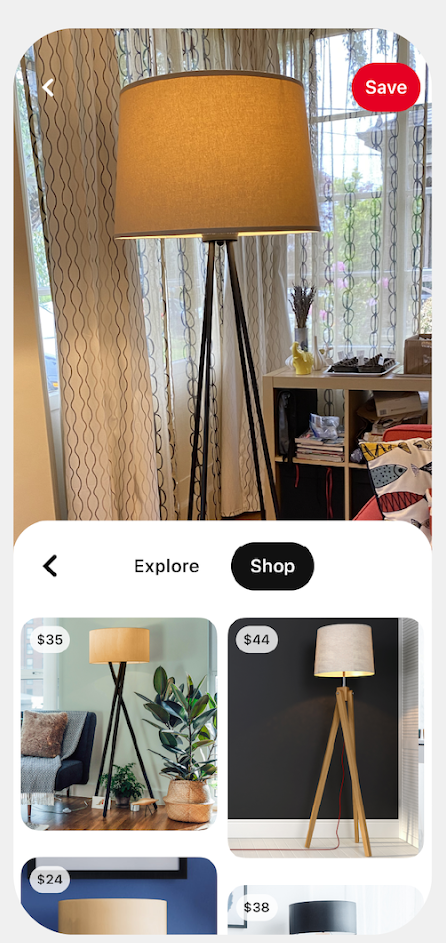
Shop from Try On – Now you can envision what a product will look like on your body or in your space with the Try On feature. Try On works in 3D to give you a better sense of everything from makeup and clothing to home decor.
One of the classic detriments of online shopping is that there is no way to see if you actually like an item in person before it’s paid for and delivered. With the Try On feature, you can get a feel for products without having to ask an attendant for a fitting room. It’s no wonder Pinners are 5x more likely to make purchases from try-on pins when compared to standard pins.
Final Tips for Making Pinterest Work for Your Influencer Campaign
As with any social media site, the way the general public uses Pinterest, and the way businesses use it differ greatly. You can’t simply expect to put up a few boards, pin a few images to them, and suddenly attract loads of web traffic. You have to do things differently to get the best results.
ADD PINTEREST SAVE BUTTONS TO YOUR SITE
You want to be sure that it’s not just you pinning your content on the site. You want your followers, customers, and potential leads to be doing it as well. The best way to do this is to make it as easy as possible for them to share your content. By including a pin button on your site, you can increase the amount of content pinned from your site by up to 5x as much.
You can install permanent pin buttons to each image, or use hover buttons that only appear when a user moves the cursor over an image. The latter can often look cleaner and allow your pictures to maintain their visual integrity. But, by having a permanent button, you’re making it easier and more obvious for users to take advantage of the option.
PIN CONSISTENTLY
Dumping all of your pins in one go is not recommended. Instead, you should aim to pin at least once a day, ideally in the evenings or at weekends if you’re working with the U.S. market. Spread your pinning throughout the day and week to help keep a consistent schedule going. As with any marketing – consistency really is key.
PLAN AHEAD FOR HOLIDAYS
When it comes to holidays or special event marketing, plan to start pinning around 45 days in advance. This gives your pins time to get traveling around the site and attract more attention.
MAKE YOUR PINS ACCESSIBLE
For many of us, it’s easy to forget that not everyone who uses social media can consume the content in the same way as us. Pinterest is a highly visual platform, so this can be severely limiting for those with visual disabilities. There are ways you can make your content more accessible, helping to expand your audience even further.
For instance, if someone needs to use screen readers to access visual content online, text over images won’t register as text to them. This means that you need to incorporate proper pin descriptions to really make your pins work for you. Also, make sure that any fonts you choose to use are as clear and easy to read as possible. Finally, don’t forget to be conscious of your color choices. If you take the time to use color contrast ratios, not only will it make your content easier to read, it will also make it look more appealing in terms of design.
PROMOTE YOUR PINS
If you have a marketing budget for social media, you should definitely consider plugging some of that cash into a Pinterest strategy. There are two different options when it comes to spending money on marketing your pins – promoted pins and shoppable pins.
Promoted pins work in pretty much the same way as promoted posts on any other network. You pay money to have Pinterest show your pin to people who you select through targeting. How many people see it will depend on your ad budget. They identify these posts with a small “promoted” button on the bottom of your image, and viewers can select that button to see more information about who promoted it.
The difference with using these promoted pins on Pinterest though, is that once a user pins your pin to their board, they begin to act like organic pins. This is why promoting on Pinterest can really help your budget travel further. In fact, according to Pinterest, brands who launch ad campaigns on the platform received an average of 20 percent more organic clicks.
USE BUYING PINS
These pins are ideal for when you have multiple items to promote in each image. They appear pretty similar to promoted pins, but they have little dots over each product that you can click through and buy.
Pinterest recommends that you include between 4-6 buyable items in each pin to get the best results. Each link should go directly to the object when possible to make it easier for users to engage with.
It pretty much goes without saying, but these pins are optimized for generating sales, so if brand awareness is your goal, you’d be better sticking with the traditional promoted pins.
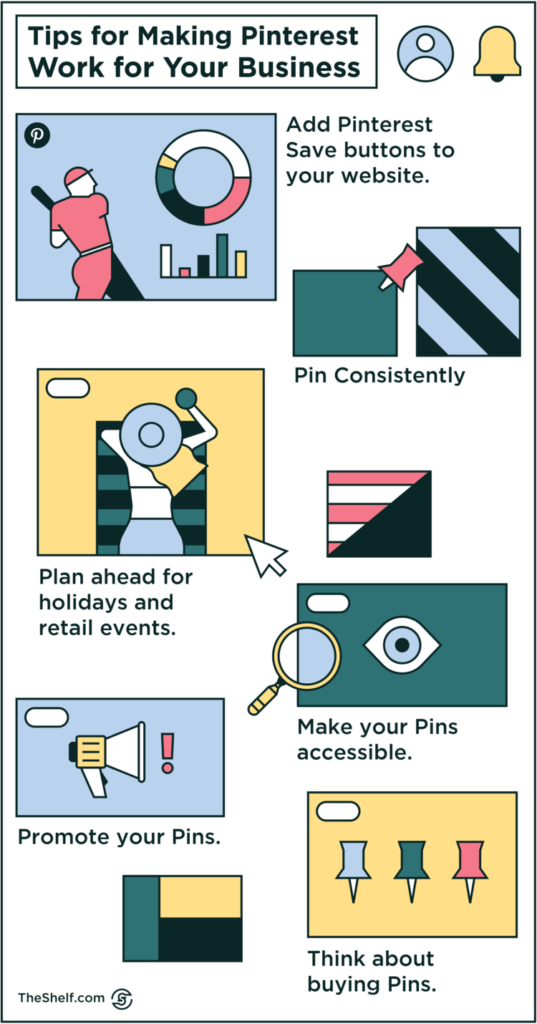
COPY AND PASTE THIS CODE TO EMBED ON YOUR SITE
TL; DR – Pinterest is Effective AF
Pinterest is one of those great online tools that you can really get results from, even without spending a dime. It is still extremely underused by many businesses, so now really is the time to capitalize on the opportunity and get ahead of your competition.
Pinterest is a visual discovery platform where users go to dream, get inspired, and perhaps most important to brands…to plan purchases. More than half of active users open their apps in the store to use as a shopping list.
When it comes to your Pinterest marketing strategy, you can’t really phone it in. The returns will be better if you can get in there and do the work. Spend the time nailing your Pinterest marketing strategy. Design great-looking pins, schedule them out across the week, and build your boards around the best keywords for your brand. Do all this, and you’ll be winning.
(Thanks, Ariana for making this post way more awesome. You’re such a friggin’ rock star!)


